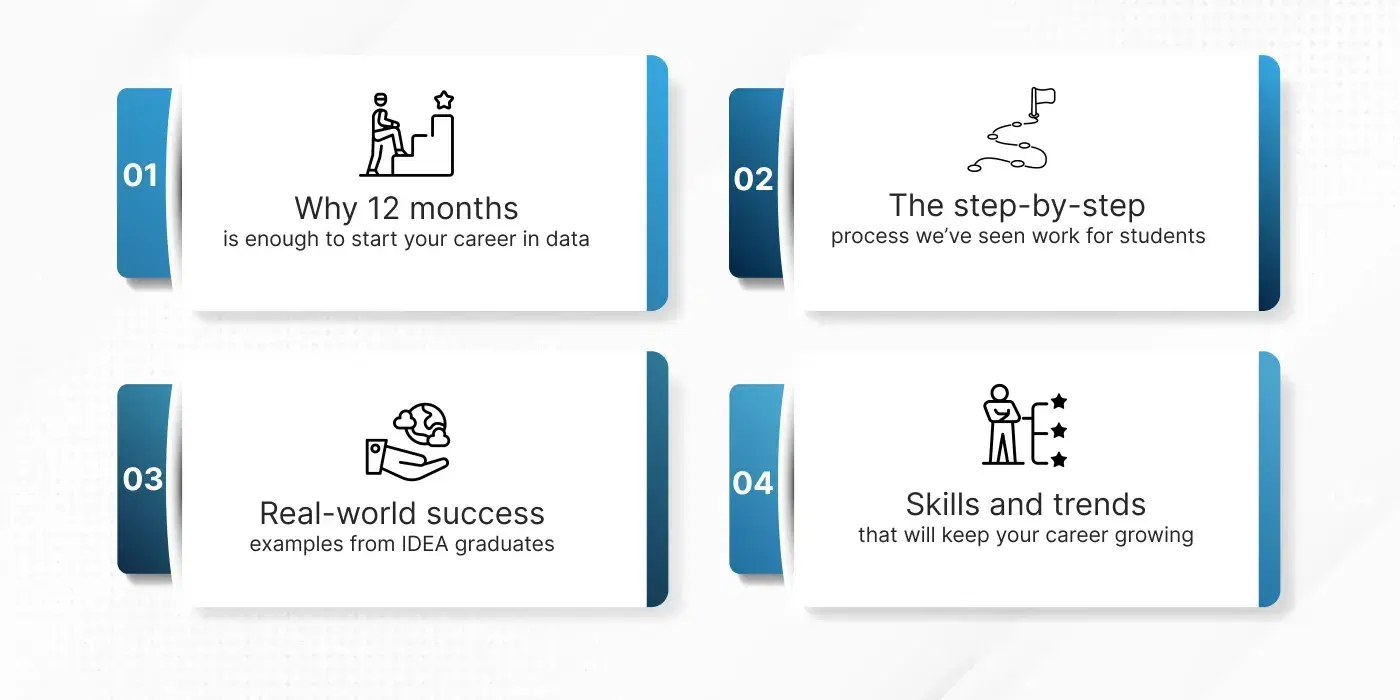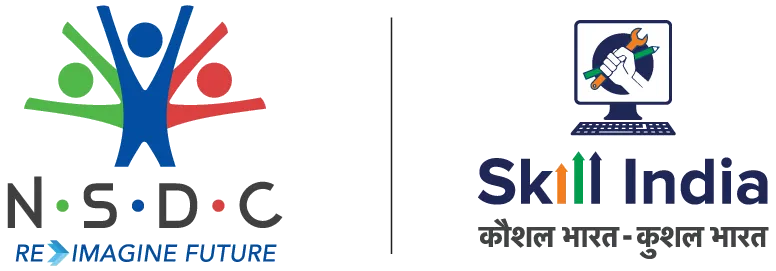It sounds almost unbelievable: going from a fresh graduate (or even a non-tech role) to a high-paying data career in less than 12 months. Yet, in today’s market, students who follow the right training, projects, and placement strategy are doing exactly that..
But here’s the thing — not every course or certification can deliver this. The truth is, the difference lies in what you learn, how you learn it, and how you apply it to real-world scenarios.
At IDEA – Institute of Data Engineering & Analytics, our goal isn’t just to teach tools — it’s to turn you into a job-ready, future-proof professional.
This blog will walk you through:

Why the Data Career Path Is Different and Faster
Unlike other tech fields that require years of formal experience, data roles are skill-first. Employers care more about whether you can solve their data problems than about your exact years of work.
According to NASSCOM’s 2024 report:
- 68% of data analytics job openings are open to freshers or candidates with less than 2 years of experience.
- Students with hands-on project portfolios get shortlisted 2.4x faster.
- Cloud data and analytics skills see salary premiums of 20–30% over traditional IT roles.
This means the right 12-month learning + portfolio strategy can launch your career faster than traditional IT pathways.
Step 1 – Learning Industry-Relevant Skills
The first 3–4 months of your training should cover core technical skills that appear in most job descriptions:
| Skill | Why Employers Want It | How IDEA Covers It |
|---|---|---|
| SQL | Essential for querying and managing data | Basic to advanced SQL + optimization |
| Snowflake | Leading cloud data warehouse | Full module with real data loading & transformation |
| GIT | Version control for collaboration | Hands-on branching, merging, pull requests |
| Big Data Tools | Handle large datasets efficiently | Intro to Hadoop & Spark with examples |
| Power BI/Tableau | Data visualization and storytelling | Build interactive dashboards |
| Python for Data | Data cleaning, automation, analytics | Applied scripts for analytics workflows |
IDEA Approach: Every skill is taught alongside a real-world mini-project, so you’re not just learning commands but applying them immediately.
Step 2 – Building Your Portfolio
By Month 5–6, you should already have 3–4 projects that demonstrate your ability to work on real-world problems.
Example Projects from IDEA Students:
- Healthcare Analytics Dashboard – Built in Power BI using anonymized patient data, highlighting risk trends and preventive measures.
- Sales Forecasting Pipeline – Using SQL + Snowflake for storage, Python for forecasting models.
- E-Commerce Customer Segmentation – Cluster analysis for targeted marketing campaigns.
- Logistics Route Optimization – Combining big data with visualization for delivery efficiency.
Why This Works: Recruiters can see you’ve already worked with messy, real datasets, which is exactly what you’ll face on the job.
Step 3 – Getting Practical Exposure Through Internships
Internships bridge the gap between academic learning and corporate realities.
At IDEA, internships are built into the training:
- Duration: 2–3 months
- Industries Covered: Healthcare, finance, retail, e-commerce
- Deliverables: A working solution or report presented to a client or mentor panel
Success Story:
Rohan Mehta, a final-year B.Tech student, took the IDEA Data Analytics Internship module. His project on real-time inventory monitoring for a retail chain directly impressed a recruiter, leading to a full-time offer before his graduation results were out.
Step 4 – Mastering Interview & Placement Skills
Many students fail interviews not due to lack of skill, but due to:
- Inability to explain their thought process
- Nervousness during problem-solving rounds
- Poor communication in HR interviews
IDEA’s Placement Prep Includes:
- Mock interviews with feedback
- Technical problem-solving practice
- HR and behavioral interview coaching
- Resume optimization for Applicant Tracking Systems (ATS)
Statistic: IDEA students see an 85% placement rate within 3–6 months of completing training.
Real-World IDEA Graduate Examples
1. Aditi Sharma – MCA to Cloud Data Engineer
- Joined IDEA with zero cloud experience.
- Built a Snowflake-based data warehouse for a sales analytics project.
- Hired by a fintech company with a ₹8.2 LPA package, 40% above market average for freshers.
2. Simran Kaur – Career Switch to BI Analyst
- Background in a non-technical support role.
- Learned Power BI, SQL, and data storytelling.
- Landed a role as a Business Intelligence Analyst in an e-commerce firm, doubling her salary in 10 months.
3. Arjun Verma – B.Tech Fresher to Big Data Engineer
- Completed IDEA’s Big Data Analytics Training.
- Worked on log processing using Hadoop and Spark for a mock transport company.
- Hired by a tech startup building real-time tracking solutions.
Career Timeline – From Zero to Data Pro in 12 Months
| Months | Without Training | With IDEA Training |
|---|---|---|
| 0–3 | Self-study, inconsistent progress | Learn SQL, Snowflake, GIT, Python, Visualization |
| 4–6 | Still searching for internships | Build portfolio projects + start internship |
| 7–9 | Applying to jobs without responses | Placement prep + apply via IDEA’s network |
| 10–12 | Maybe get first interview | Secure job offer + join as Analyst/Engineer |
Future-Proof Skills for Long-Term Career Growth
| Skill | Current Demand | 5-Year Relevance |
|---|---|---|
| SQL | 90% of data jobs | Still essential |
| Cloud Data Warehousing | 80% | Growing |
| Big Data Processing | 70% | Growing |
| Data Visualization | 75% | Stable demand |
| AI/ML for Data | 65% | Rapid growth |
Why This Matters: Training with IDEA ensures you start strong and stay relevant by mastering both current and emerging skills.
IDEA’s Unique Advantage
- Industry-Aligned Curriculum – Updated quarterly to match hiring trends.
- Portfolio-First Approach – Every module tied to a real-world deliverable.
- Placement Partnerships – Direct connections with hiring companies.
- Alumni Support – Continued access to resources and mentors even after placement.
Conclusion
Yes — you really can build a high-paying data Analytics career in under a year. The key is not just learning tools, but combining technical mastery, project experience, internship exposure, and strong interview skills into one career strategy.
That’s exactly what IDEA Institute provides — turning fresh graduates into employable, confident professionals ready for the data industry’s present and future.

